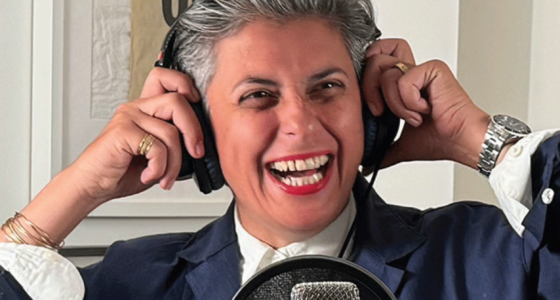How the CJN’s latest resurgence is learning from its history to ensure its future.
Towards the end of March 2021, the Canadian Jewish News (CJN) released a magazine a few days before the Jewish festival of Passover; the first issue they’ve had in print in nearly a year. Its cover features a cartoon drawing of a red-headed man wearing a kippah standing in front of a Seder plate, his face illuminated by the din of a smartphone. It’s a nod to the efforts of Canadian Jews who strive to experience some semblance of togetherness as COVID-19 forced them to observe the holiday in isolation for the second year running.
The CJN magazine is a major part of editor-in-chief and CEO Yoni Goldstein’s second stab at reviving the publication. More than half-a-century old, the CJN is in the midst of its second resurrection within the last ten years. But in its latest avatar, one marked by a shift in organizational structure, as well as style and focus, one of only a few remaining national Canadian Jewish publications is hoping to forge a more stable and enduring future.
The relaunch is the brainchild of Goldstein and the CJN’s new president, Bryan Borzykowski, an entrepreneur and accomplished business journalist with bylines at CNBC, the Globe and Mail, and BBC.
Part of the pairs’ vision is to dramatically dial back the print edition of the paper from weekly installments to a quarterly magazine distributed a few times annually. They also want to focus on multimedia content like podcasts, as well as overhauling and expanding the CJN’s online presence. Additionally, they want to hold events (virtual, for now), and are looking into producing branded content and creating a new subscription model.
The attempt is certainly ambitious, and in an era of Canadian media defined by disruption and instability, its success is far from assured.
The End
On April 13, 2020, then-president of the CJN, Elizabeth Wolfe, penned a letter to the paper’s readers that had a eulogy’s air of finality, concluding with the phrase, “everything has its season. It is time.”
The COVID-19 pandemic was forcing the CJN to call it quits after 60 years in print.
Wolfe’s family has been involved with the CJN since 1971 when her father, Ray Wolfe, led a group of prominent Jewish community members in purchasing the paper from its founder, Meyer Joshua Nurenberger. The long-standing connection made the decision to close feel personal.
“It felt very much like a death,” Wolfe says.
The paper had left Wolfe feeling devastated before. In 2013, the CJN suspended operations for the first time due to a steep decline in advertising revenue. Fifty full-time staff members were laid off during that hiatus, some permanently.
The CJN is a vital publication mainstay among many Jewish communities across Canada, especially in Montreal and Toronto. The announcement that it was closing in 2013 resulted in outcries from more than 30,000 readers who rely on the publication for news about Jewish events and a feeling of connection to the broader community.
Wilf Mandel, a real estate agent now in his 70s, has been reading the CJN for decades. He says he felt disappointed both times the paper shut down. “There was no voice of the Jewish community,” he says. For him, the CJN’s closure was especially unfortunate amidst what he sees as “a constant rise in anti-Semitic events in Canada [and] around the world.”
Following a substantial restructuring, along with some contributions from individual supporters, the paper was able to resume publication the same year it shut down. Wolfe stepped in as president after spearheading prior restructuring efforts, including a key personnel change which saw long-time editor Mordechai Ben-Dat replaced by Yoni Goldstein, formerly an editor at Postmedia, National Post,and Maclean’s, and before that, the Canadian correspondent with the Jerusalem Report. “The print product changed from a newspaper into a news magazine that was focused on analyzing what was happening in the Jewish context, versus just regurgitating whatever Jewish-adjacent stories mainstream media was doing,” says Goldstein.
Now, for the second time in the last decade, Goldstein is being tasked with bringing the CJN back from the dead.
“There was no voice of the Jewish community.”
In February 2020, COVID-19 forced the closure of businesses across Canada, placing a severe strain on the publication’s finances. As Canada initiated lockdowns to slow the spread of the pandemic, thousands of dollars in advertising were lost rapidly, says Bryan Borzykowski.
Borzykowski, 41, was brought on as a board member in February of 2020, in part to inject some youth into the group. He says that during his first board meeting that month, there was no discussion of shuttering the paper; there were, in fact, talks of expanding the staff to include a digital editor—an attempt to modernize.
Once the pandemic hit, though, the uncertainty of when—or if—advertising revenue would return made pulling the plug seem like a prudent move. The decision was made to cease publication before they were forced to go into debt.
Over the next few months, employees were laid off, contracts were closed, and the premises vacated. The CJN was reduced to a dormant website and a bank account.
The Beginning
In 1960, Meyer Joshua Nurenberger and his wife Dorothy Cohn Nurenberger launched the CJN amidst considerable anti-Semitic backlash. Ahead of the first issue’s release, they reportedly received several death threats. For a time, their daughter had to walk to school with a police escort.
In Nurenberger’s obituary published by the Globe and Mail in 2001, his daughter, Atara Beck, said that her father, “believed that a newspaper should be a thorn in the side of the establishment.” Meyer used the paper as a mouthpiece for criticizing the policies of the Canadian government, and to challenge the hegemony of what he saw as liberal mainstream Jewish organizations, like B’nai Brith Canada and the United Jewish Appeal.
Meyer sold the paper a year after Dorothy’s death in 1970, and watched with dismay as the new leadership blunted it’s political messaging over the next few decades, turning it into a community publication. According to Elizabeth Wolfe, readership increased dramatically under the new regime, but, by the 1990s, the CJN became somewhat of a community lapdog, shying away from any topics with the potential to cause controversy.
“The paper got dull,” said Wolfe, “People just didn’t find it an interesting read.”
That seemed to be changing under Wolfe and Goldstein’s leadership. The CJN got a bit younger, and the editorial staff became less afraid to go out on a limb. The paper started publishing articles about subjects that, in the past, may have been considered taboo, like spousal abuse, mental health, and inclusivity within the community.
According to his daughter, Nurenberger “believed that a newspaper should be a thorn in the side of the establishment.”
“I thought that if we could put some of those stories out there and at least put faces and names to them, we could help organizations that were doing good work and also bring a new sort of reader into the CJN community,” said Goldstein.
There were even op-eds printed that featured criticism of the community’s relationship with Israel, historically a no-go zone for the publication. The effort to include a diversity of opinion on the subject was not uniformly welcomed.
Mira Sucharov, a columnist at the paper, decided to discontinue her nearly 2-year-running monthly column in 2017 after receiving backlash when she referred to the Israeli “occupation” of Palestinian territory in an article.
“I had begun to feel like I was a geologist who had been hired to write a regular column for the community paper of the Flat Earth Society,” Sucharov wrote in a CJN column explaining her decision.
Not everyone was so vehemently opposed to dissenting views, though. Long time CJN reader, and occasional contributor, Randi Skurka, said that even as a fervent and outspoken zionist, she appreciates the CJN’s diversity of opinion. Despite feeling like the paper sometimes veered too far left for her tastes, she says that overall “it’s a good thing to have discussions and dialogue.”
Stirring the pot can be particularly consequential for outlets like the CJN, which are typically reliant on a small pool of subscribers and local community advertisers.
“There were one or two articles that triggered a response from an individual or an advertiser, who said I didn’t like what you said about x, y or z, and I’m not supporting you anymore,” said Wolfe. “A single advertiser can make a big difference to your bottom line.”
Even with the pushback, Goldstein and Wolfe agree that feedback to the paper’s new direction was generally positive. According to Wolfe, the paper’s struggles leading into the recent shutdown were due more to shifts in the media landscape and changing behaviours within the Jewish community.
The Re-rebirth
Regardless of generational shifts, Borzykowski and Goldstein remain convinced that–if they approach it right–there exists a sufficient appetite for the Jewish perspective in Canada to keep an entity like the CJN viable.
“The need was still there, the opportunity was still there, it was just, how do you make it work?” Borzykowski said.
Their chances of success may be bolstered by an emerging revenue stream: donations.
The CJN is in the process of receiving Registered Journalism Organization status with the Canada Revenue Agency (CRA), a designation that allows non-profit news organizations to give out tax receipts in exchange for financial contributions. They’re hopeful that this will encourage generosity on the part of the community.
Wolfe concedes that donations by themselves won’t save the paper, but says that the designation may be useful “as an add on to get you over the hurdle, [to prevent] you from going under.”
The new CJN magazine is markedly sleeker than previous iterations and it’s new focus on long-form content has given it a more literary feel. It seems that the refreshed format is finally allowing Goldstein to start creating the Jewish magazine he’d envisioned since taking the reins.
In his editor’s note in the magazine, Goldstein writes that the revamped publication, “follows in the best traditions of the CJN—as both a journalistic and communal publication—while also moving that legacy forward in ways we hope will connect and reflect new audiences, young and old, across Canada.”
It’s a nice sentiment, but therein lies the biggest challenge facing the new CJN: balancing a desire to modernize and cultivate a younger readership, with the risk of alienating the older audience and community who have been following the paper for decades.






